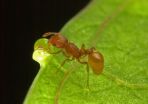(Press-News.org) CAMBRIDGE, MA -- Many years of research have shown that for students from lower-income families, standardized test scores and other measures of academic success tend to lag behind those of wealthier students.
A new study led by researchers at MIT and Harvard University offers another dimension to this so-called "achievement gap": After imaging the brains of high- and low-income students, they found that the higher-income students had thicker brain cortex in areas associated with visual perception and knowledge accumulation. Furthermore, these differences also correlated with one measure of academic achievement -- performance on standardized tests.
"Just as you would expect, there's a real cost to not living in a supportive environment. We can see it not only in test scores, in educational attainment, but within the brains of these children," says MIT's John Gabrieli, the Grover M. Hermann Professor in Health Sciences and Technology, professor of brain and cognitive sciences, and one of the study's authors. "To me, it's a call to action. You want to boost the opportunities for those for whom it doesn't come easily in their environment."
This study did not explore possible reasons for these differences in brain anatomy. However, previous studies have shown that lower-income students are more likely to suffer from stress in early childhood, have more limited access to educational resources, and receive less exposure to spoken language early in life. These factors have all been linked to lower academic achievement.
In recent years, the achievement gap in the United States between high- and low-income students has widened, even as gaps along lines of race and ethnicity have narrowed, says Martin West, an associate professor of education at the Harvard Graduate School of Education and an author of the new study.
"The gap in student achievement, as measured by test scores between low-income and high-income students, is a pervasive and longstanding phenomenon in American education, and indeed in education systems around the world," he says. "There's a lot of interest among educators and policymakers in trying to understand the sources of those achievement gaps, but even more interest in possible strategies to address them."
Allyson Mackey, a postdoc at MIT's McGovern Institute for Brain Research, is the lead author of the paper, which appears the journal Psychological Science. Other authors are postdoc Amy Finn; graduate student Julia Leonard; Drew Jacoby-Senghor, a postdoc at Columbia Business School; and Christopher Gabrieli, chair of the nonprofit Transforming Education.
Explaining the gap
The study included 58 students -- 23 from lower-income families and 35 from higher-income families, all aged 12 or 13. Low-income students were defined as those who qualify for a free or reduced-price school lunch.
The researchers compared students' scores on the Massachusetts Comprehensive Assessment System (MCAS) with brain scans of a region known as the cortex, which is key to functions such as thought, language, sensory perception, and motor command.
Using magnetic resonance imaging (MRI), they discovered differences in the thickness of parts of the cortex in the temporal and occipital lobes, whose primary roles are in vision and storing knowledge. Those differences correlated to differences in both test scores and family income. In fact, differences in cortical thickness in these brain regions could explain as much as 44 percent of the income achievement gap found in this study.
Previous studies have also shown brain anatomy differences associated with income, but did not link those differences to academic achievement.
In most other measures of brain anatomy, the researchers found no significant differences. The amount of white matter -- the bundles of axons that connect different parts of the brain -- did not differ, nor did the overall surface area of the brain cortex.
The researchers point out that the structural differences they did find are not necessarily permanent. "There's so much strong evidence that brains are highly plastic," says Gabrieli, who is also a member of the McGovern Institute. "Our findings don't mean that further educational support, home support, all those things, couldn't make big differences."
In a follow-up study, the researchers hope to learn more about what types of educational programs might help to close the achievement gap, and if possible, investigate whether these interventions also influence brain anatomy.
"Over the past decade we've been able to identify a growing number of educational interventions that have managed to have notable impacts on students' academic achievement as measured by standardized tests," West says. "What we don't know anything about is the extent to which those interventions -- whether it be attending a very high-performing charter school, or being assigned to a particularly effective teacher, or being exposed to a high-quality curricular program -- improves test scores by altering some of the differences in brain structure that we've documented, or whether they had those effects by other means."
INFORMATION:
The research was funded by the Bill and Melinda Gates Foundation and the National Institutes of Health.
Geneva, Switzerland, 17 April 2015 -- Cancer DNA circulating in the bloodstream of lung cancer patients can provide doctors with vital mutation information that can help optimise treatment when tumour tissue is not available, an international group of researchers has reported at the European Lung Cancer Conference (ELCC) in Geneva, Switzerland.
The results have important implications for the use of cancer therapies that target specific cancer mutations, explains Dr Martin Reck from the Department of Thoracic Oncology at Lung Clinic Grosshansdorf, Germany, who presented ...
Geneva, Switzerland, 17 April 2015 -- Almost one in four patients (24%) with advanced lung cancer in Europe, Asia and the US are not receiving EGFR test results before being started on treatment, researchers report at the European Lung Cancer Conference.
Medical Oncologist James Spicer from King's College London at Guy's Hospital, London, and colleagues studied how widely hospitals had implemented testing for mutations in the epidermal growth factor receptor gene among lung cancer patients.
Targeted therapies can more effectively treat cancers that are known to carry ...
Recent research published in The Diabetes Educator by Dr. Shiela Strauss, associate professor of nursing and co-director of the Statistics and Data Management Core for NYU's Colleges of Nursing and Dentistry, along with a team of NYU researchers, reveals differing perceptions among adult populations at-risk for diabetes that may offer new approaches to diabetes education and prevention.
"We found that there are differences in the perceptions of those who are at risk for diabetes that depend on the specific characteristics that place them at risk," said Strauss.
Illness ...
A team from Disney Research and Carnegie Mellon University have devised a 3-D printer that layers together laser-cut sheets of fabric to form soft, squeezable objects such as bunnies, doll clothing and phone cases. These objects can have complex geometries and incorporate circuitry that makes them interactive.
"Today's 3-D printers can easily create custom metal, plastic, and rubber objects," said Jim McCann, associate research scientist at Disney Research Pittsburgh. "But soft fabric objects, like plush toys, are still fabricated by hand. Layered fabric printing is one ...
Disney Research has demonstrated that battery-free, radio frequency identification (RFID) tags can be used to cheaply and unobtrusively determine how people use and interact with daily objects, enabling new types of interactive play, smart homes and work environments, and new methods for studying consumer shopping habits.
RFID tags are designed to simply report an identifying code when energized by an RFID reader, but a Disney Research team directed by Dr. Alanson Sample showed that the radio frequency signals transmitted by these tags provide a unique RF signature which ...
An international team of scientists have put forward a blueprint for a purely space-based system to solve the growing problem of space debris. The proposal, published in Acta Astronautica, combines a super-wide field-of-view telescope, developed by RIKEN's EUSO team, which will be used to detect objects, and a recently developed high-efficiency laser system, the CAN laser that was presented in Nature Photonics in 2013, that will be used to track space debris and remove it from orbit.
Space debris, which is continuously accumulating as a result of human space activities, ...
Half of all patients who survive a cardiac arrest experience problems with cognitive functions such as memory and attention. This has been shown by a major international study led from Lund University. Surprisingly, however, a control group comprising heart attack patients had largely the same level of problems. This suggests that it is not only the cardiac arrest and the consequent lack of oxygen to the brain that is the cause of the patients' difficulties.
The study led by Lund University involved 950 cardiac arrest patients in Europe and Australia. Six months after ...
This news release is available in Japanese.
It seems unnatural that a species could survive without having sex. Yet over the ages, evolution has endowed females of certain species of amphibians, reptiles and fish with the ability to clone themselves, and perpetuate offspring without males. Researchers at the at the Okinawa Institute of Science and Technology Graduate University (OIST) found that in species where females have evolved the ability to reproduce without males relatively recently, fertilization is still ensuring the survival of the maximum number of healthy ...
Scientists at the Vetmeduni Vienna investigated whether stomach ulcers in cattle are related to the presence of certain bacteria. For their study, they analyzed bacteria present in healthy and ulcerated cattle stomachs and found very few differences in microbial diversity. Bacteria therefore appear to play a minor role in the development of ulcers. The microbial diversity present in the stomachs of cattle has now for the first time been published in the journal Veterinary Microbiology.
Gastritis and stomach ulcers in humans are often caused by the bacterium Helicobacter ...
Breast cancer patients often display mild cognitive defects even before the initiation of chemotherapy. A new study by Ludwig-Maximilians-Universitaet (LMU) in Munich researchers now attributes the syndrome to post-traumatic stress induced by diagnosis of the disease.
A large number of studies have shown that cancer patients very often exhibit mild deficits of attention, memory and other basic cognitive functions. The phenomenon has generally been attributed to putative side-effects of chemotherapeutic drugs on the brain, and the condition is therefore popularly referred ...

